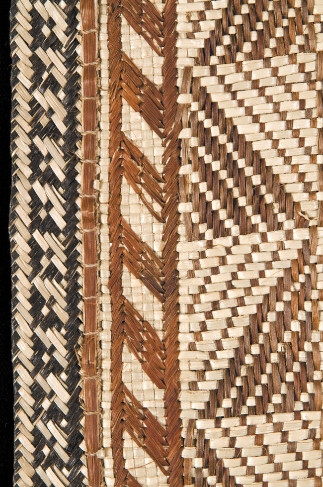Warp and Weft of the Pacific Islands
“Weaving is universal. It is the base of life … oh, maybe too dramatic, but we use the word ‘weaving’ to describe all kinds of coming together of ideas, of opinions and of people. And so a weaving symposium has such a good ring to it,” says Bishop Museum’s director of cultural collections Betty Kam.
The museum is hosting a weeklong weaving symposium, where local weavers, as well as experts from French Polynesia and the Marshall Islands, will display their skills. Visitors will have a chance to watch the work in progress, ask questions and take photos.
mw-art-091113-weave-1
“Weaving is a universal language,” says Kam. “It is a commonality that should be celebrated, practiced and used to unite.”
As Kam points out, textiles have largely become the domain of factories, so to experience traditional techniques firsthand is a rare and informative experience.
Of special note are the Marshallese weavers who have recently experienced a cultural revival, particularly in regard to finely woven, symbolically designed mats, known as jaki-ed.
“This revival is tied to Bishop Museum in a wonderful way,” says Kam. “Over the past few years, Bishop Museum mats have gone to the Marshalls during an annual gathering of weavers. These examples of early mats – 1800s to early 1900s – have stimulated interest and motivated weavers to regain what has been lost. And the weavers have gone on to creating their wonderful jaki-ed or mats worn as clothing.”
The symposium exemplifies the museum’s function as a gathering place and nexus of information on Hawaii’s heritage. The event culminates Sept. 21, the same day the recently renovated Pacific Hall will reopen to the public with a full day’s schedule of programs. Shells, musical instruments, deities, canoe models, adzes, pottery, fishing tools, costumes and a multitude of additional artifacts will educate Pacific Hall visitors about Hawaii’s connection to the various Pacific cultures both familiar and rarely heard about, whether the Caroline Islands, the Marquesas, Futuna or the Austral Islands.
the TICKET stub
WEAVERS SYMPOSIUM
When: Sept. 16-21, 10 a.m.-4 p.m. daily
Where: Hale Ikehu, Bishop Museum
Cost: General admission, $8.95-$19.95
More Info: bishopmuseum.org
ALSO SHOWING
Hawaii’s Manga
Based on history, culture or their own personal stories, the works of 12 of Hawaii’s top manga artists and writers are on display.
The show, Crossing Cultures: The Art of Manga in Hawaii, is up through Oct. 2 in Gallery ‘Iolani at Windward Community College (hawaiimanga.com, gallery.wcc.hawaii.edu, 236-9155).
“I like to call them artists who use manga,” says show coordinator Brady Evans, whose work is on exhibit. After all, though they use traditional manga drawing techniques, they cull their inspiration from various genres and sources, be it American superhero, Sunday comics, anime, Japanese live action TV shows or Japanese manga.
“Many of the artists also draw from their experiences growing up in Hawaii,” notes Evans. Work by MidWeek cartoonist Roy Chang, author of manga novel Cacy and Kiara, will be among more than 30 featured items, as will entries from Jon J. Murakami and Audra Furuichi, both of the Star-Advertiser‘s comics pages.
“For anyone who has never picked up a manga book in their life, but would like to learn more, the first few sections of the exhibition are dedicated to a brief history of manga and its origins in Japanese art history,” notes Evans. “Following this, we explore the massive influx of Japanese pop culture to Hawaii in the 1970s with TV shows like Kikaida, which laid the groundwork for manga’s healthy reception in Hawaii in the 1990s and 2000s.”
An activity room will welcome visitors to pick up some colored pencils and try their own hand at manga, and it just may end up on the exhibition wall! Show up any Sunday and the artists will be in house 2-4 p.m. For those to whom manga and costumed Kawaii Kon fanatics come to mind, this free exhibit makes for a user-friendly intro so that manga is accessible to everyone.






